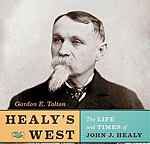
Healy’s West: The Life and Times of John J. Healy, by Gordon E. Tolton, Mountain Press Publishing Co., Missoula, Mont., 2014, $20
Some Westerners became legends, others led legendary lives but never made it into dime novels or onto the big screen. John Healy was one of the latter, though Canadian author Gordon Tolton aims to redress that with a picaresque biography spanning two nations and two centuries.
Of all the trials and tribulations on which Healy himself commented, the only part of his life on which he said virtually nothing was his childhood in Ireland. The author’s recap of British injustices and the economic ripple effects of the potato famine will at least give the reader an inkling of why. From his family’s arrival in New York, Healy assessed the seemingly boundless possibilities of the New World and set his ambitions westward—traveling on the taxpayer’s dollar as a soldier on the 1857 expedition to Mormon Utah. After leaving the Army and meeting renowned mountain man Jim Bridger, Healy guided wagon trains on the Oregon and Bozeman trails, learned to apply his Irish gift of gab to talking and bluffing his way out of trouble with Shoshones, and then tried panning for gold in what became Montana.
That was just the start of his remarkably diverse career as an entrepreneur, lawman and politician, during which he clashed with the monopolistic Hudson’s Bay Co., hunted down numerous outlaws without ever drawing blood (which may explain why he never made a name for himself in certain circles), mastered the art of “how to win friends and influence people” when trading with Bloods and Piegans, outfitted prospectors in Alaska and the Klondike and in his later years entertained a wild idea (even by present-day standards) of running a 44-mile railroad tunnel beneath the Bering Strait. The tracks he envisioned would cross Canadian and American territory and connect with Russia’s Trans-Siberian Railway, to the benefit of all three countries. By 1905 that scheme had collapsed for a variety of financial and political reasons. While recounting the remarkable Western adventures of a man who seized at opportunity with nearly unerring instinct, the author notes: “That same resolve proved useless in the boardroom. Such determination caused him to overreach, when even his temper and ethics could strike no victory against the powerful or the impossible. The door he opened for so many was often slammed on him, and sometimes he walked right into it.”
Still, Healy was an enthusiastic embracer and multifaceted agent of “Manifest Destiny,” and his life runs intriguingly parallel to the history of two developing nations. Although Healy’s attitude toward Indians would be considered racist by present-day standards, he did say, “I admire the Blood Indians, I fought them for years, and when they became my friends, I could trust them absolutely.” For those who have never heard of the man, Healy’s West should prove enlightening. For those already familiar with Healy, the reward is a further introduction to this unsung Westerner.
Jon Guttman




